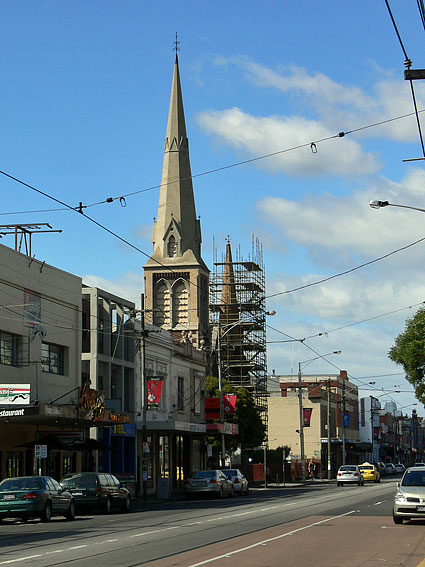Sydney Road, Brunswick
First organ B. 1907 Frederick Taylor moved to Trinity Uniting Church, Doncaster Road, Balwyn
Second organ B. 1906 Frederick Taylor for Presbyterian Church, Kew
Reb. 1960 Hill, Norman & Beard (o/n V464)
Inst. Brunswick 1996 Vernon Cresswell
Moved 2011 to St Joseph's Catholic Church, Chelsea
2m, 12 spst, 7c, elpn.


The earlier church to the right was designed by Charles Webb in bluestone with cream brick detailing and was opened in 1865. In Early English Gothic style, this has the distinction of a cream brick broach spire with lucarnes – two other examples of brick spires may be found at John Knox Church, Gardenvale (also by Webb) and the Uniting (Methodist) Church, Daylesford. In 1876 a pipe organ supplied by William Anderson was installed in this church but its present whereabouts are unknown. The interior consist of a very broad nave and transepts with a low roof; it is currently used as a hall for the congregation.
The present church was opened August 1885 and built from brown brick with cement dressings except the upper quoining of the belfry, which is in cream brick. The façade incorporates an impressive tower (with large belfry openings and scalloped louvres) and broach spire and four-light window with Geometrical tracery; the raking corbel tables recall those on the former St Philip’s, Collingwood. There is an unusual apsidal transept to the north and an iron palisade fence facing Sydney Road.
The architect of the church Evander McIver lived nearby in Park Street, Brunswick and was a prominent member of this church (a memorial plaque to him is placed on the external west wall of the church). The son of a crofter and mason, he was born in Assynt, Scotland, in 1835 and died in Melbourne in June 1902. Trained initially as a stonemason, he later became an architect and worked at Inverness before his emigration when he was around 30 years old. He was the architect of 22 Presbyterian churches in Victoria as well as a municipal engineer for 37 years for the shire of Broadmeadows. He was also town surveyor for the municipalities of North Melbourne, Brunswick, Essendon, Flemington and Kensington.
The interior of the building has its axis parallel to Sydney Road although this is not clear externally. The floor is steeply raked and the pews and aisles radiate from the central apse. Cast iron columns with intricate foliated capitals separate two smaller bays on either side from the central space; these bays have plaster vaulting. However, the main roof area is of boarded timber with inset cast iron ventilation panels.
The fittings include a cedar communion table whose timber came from a Brunswick boot maker’s shop where it had been used from 1870 to 1946 as a work bench, and other cedar furnishings including the elders' chairs were also made from donated recycled cedar. Other items of interest in the interior include the honour rolls, currently in storage, commemorating those who served in the First World War: these have panels carved with Australian flora. There is also a Gothic memorial tablet to an early minister, the Revd A. MacVean.
The stained glass consists of a large four-light window facing Sydney Road, with commemorative text and Trinity emblems in the tracery, and a three-light window in the apse, including a Last Supper panel, all the work of Ferguson & Urie, a memorial to the McIver family, who also would have supplied the glass in the other windows filled with quarries and coloured borders.
The first organ in this building was built by Frederick Taylor, of Hawthorn, in 1907 and was sited in the apse, divided on either side of the memorial window and obscuring two smaller windows on each side. It was moved to the back of the church in 1954 but later sold to Trinity Uniting Church, Doncaster Road, Balwyn. Rather miraculously, it was possible to replace it with another Taylor organ built a year earlier for the Presbyterian Church, Cotham Road, Kew – also another church designed by McIver, at a cost of £384. This instrument was installed in 1996 at Brunswick and has two manuals and 12 speaking stops, slightly smaller than the original Taylor organ. It was rebuilt in 1960 by Hill, Norman & Beard, but the only changes appear to have been the conversion of the action to electro-penumatic and the introduction of a new detached stopkey console. The façade pipes (which include some of the wooden pipes of the pedal Bourdon) have all been incongruously covered in white paint. The swell and great windchests are placed side by side. Sited at the rear of the church within a broad apse, its Gothic casework, constructed from Kauri timber, integrates perfectly with its setting. Two ranks remain prepared-for: a Voix Celeste 8 and a Cornopean 8, both on the swell.
The above from notes prepared in 2001 by John Maidment for a tour of churches and organs in Brunswick 0n 21 April 2001 as part of the Melbourne International Festival of Organ and Harpsichord.
| GREAT Open Diapason Clarabella Dulciana Principal Suabe Flute Fifteenth Swell to Great SWELL Violin Diapason Gedeckt Viola da Gamba Voix Celeste Gemshorn Cornopean Oboe Sub Octave Octave Tremulant PEDAL Bourdon Great to Pedal Swell to Pedal |
8 8 8 4 4 2 8 8 8 8 4 8 8 16 |
gvd.bass prepared-for prepared-for |
Compass: 61/30
Detached stopkey console
Electro-pneumatic action



Photos: JRM (Nov 2009)